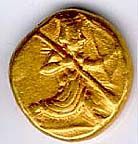 I was reading yet another discussion on the latest Troy film where archaeologists point out that coins were not placed on the eyes of the dead at that time because coins were not invented for another 500 years. I, too, had read that many academicians credit King Ardys of Lydia with minting the first coins in the 7th century B.C.E. and King Croesus with standardizing government-issued coinage However, I found this website about the history of coinage that states the first metallic coins, made of bronze and shaped like cattle, date back to approximately 2000-1800 B.C.E.
I was reading yet another discussion on the latest Troy film where archaeologists point out that coins were not placed on the eyes of the dead at that time because coins were not invented for another 500 years. I, too, had read that many academicians credit King Ardys of Lydia with minting the first coins in the 7th century B.C.E. and King Croesus with standardizing government-issued coinage However, I found this website about the history of coinage that states the first metallic coins, made of bronze and shaped like cattle, date back to approximately 2000-1800 B.C.E.
"The first metallic money dates back to approximately 2000-1800 BC and was made of bronze. These bronze pieces which traded based on weight, were often formed into the shape of cattle, which again were used prior to the general acceptance of metals as a valuable commodity. The primary reason behind the origins of coinage is a matter open for debate. One school of thought is that the first coins were struck for religious reasons.
Another suggests that they were made solely in order to help facilitate trade. Still another theory promotes the idea that man began making coins strictly for accounting and administrative reasons."
http://www.coin-gallery.com/cgearlycoins.htm
Original criticism also got me to thinking about changes in Greek religion from the time of the Trojan War to the classical period. At what point was the payment of the ferryman across the River Styx introduced? Was this introduction into Greek religion an effort by the wealthy to ensure that they did not have to mingle with the abject poor in the afterlife?
No comments:
Post a Comment